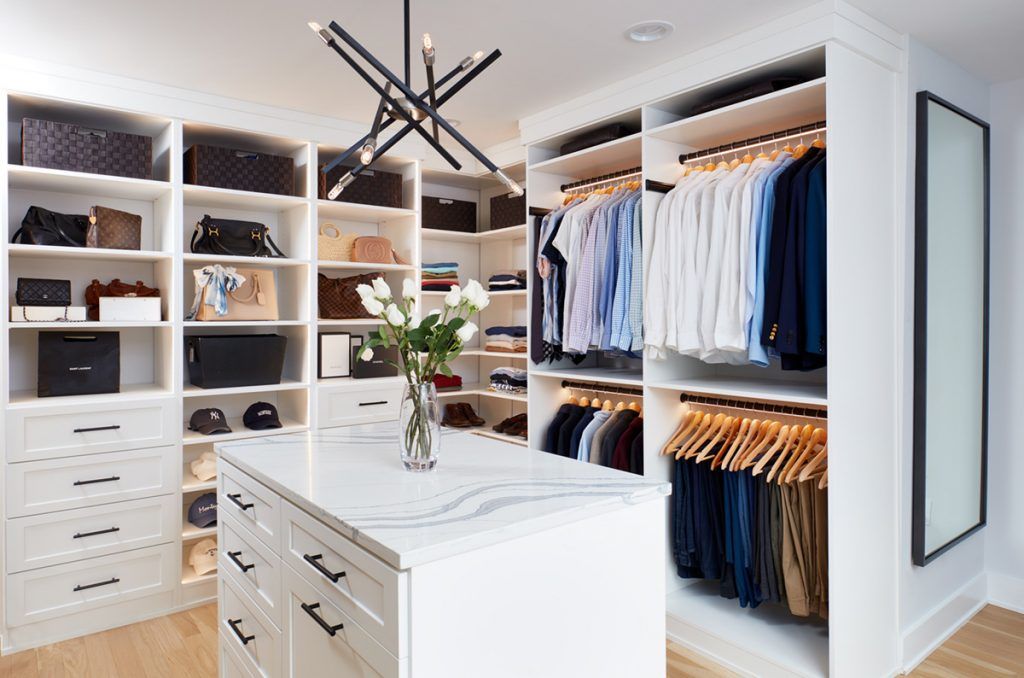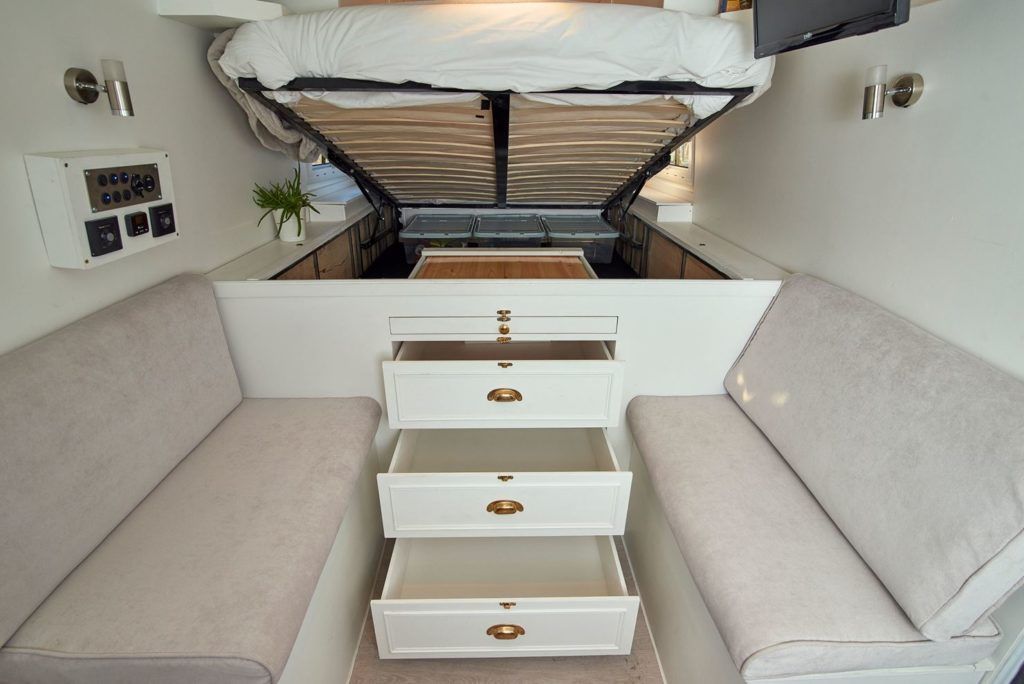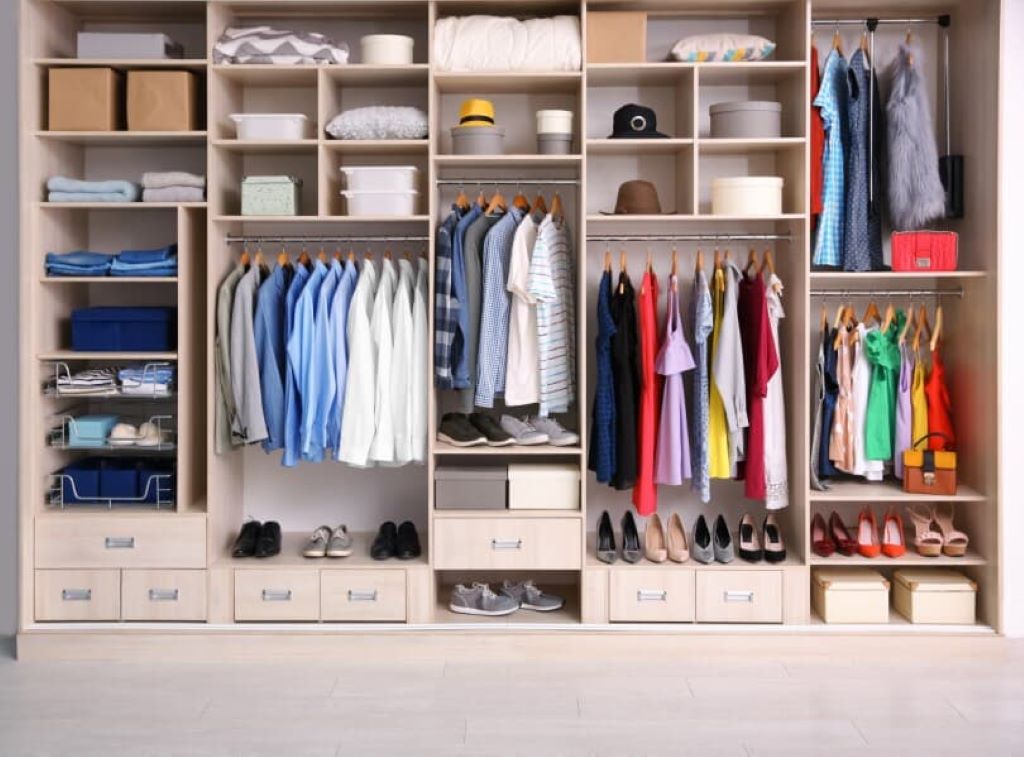As a camper owner, making the most of every square inch of storage space is essential. After all, you have a very limited area to work with compared to a stationary house. And if you love traveling for weeks or months at a time, packing effectively is even more critical. When it comes to camper storage ideas for clothes specifically, it pays to get creative. The good news? With some clever solutions, you can comfortably bring along all the wardrobe items you need without bursting at the seams. Let’s explore some of the cheapest, space-saving techniques for storing clothes in your tiny home on wheels.
Use Space Under the Bed
The area under the bed tends to be an underutilized area perfect for stashing away clothes, shoes, and other gear securely. It may not be the most accessible space, but it certainly helps maximize what you can pack.
If your bed frame doesn’t already have built-in storage, you can easily DIY some drawers or baskets that slide right into the cavity below. Make sure they are breathable and not fully sealed so condensation doesn’t build up. A set of soft-sided fabric bins on wheels or lightweight plastic drawers will do the trick on a budget.
Stick to flat, compressible items like jeans, sweaters, t-shirts and some shoes here to keep the storage low profile. Reserve everyday essentials for spots that are more convenient to access.
Optimize Closet Rods and Shelving
Most campers come equipped with a small wardrobe closet, but the rod and shelves rarely cut it for substantial clothes storage. To open up more room, replace the rod with a double bar to double your hanging capacity. Or get creative with hanging storage accessories like multi-level pants and skirt hangers, hanging shoe bags and over-the-door hooks for jackets.
Likewise, add shelving units designed to make smart use of vertical space. Stackable wire shelving with canvas bins lets you organize folded items by category, while using height efficiently. For a mini walk-in closet feel, try installing a second rod and shelf higher up, connected with a steel pole. The finished setup acts like a narrow tower to file more of what you need.
Use Space Inside Cabinets
The cabinets flanking your camper bed, kitchen and bathroom offer discreet storage spots you may not have considered for clothing. Things like folded underwear, socks, pajamas and extra linens can all be neatly arranged in empty cabinet areas.
Install organizers like retractable drawers, multi-tier wire baskets and hanging shelves tailored to make use of the unique dimensions. Having designated homes for clothing categories allows you quick access when you need it.
Just be selective of which garments go where based on how frequently you need access. Reserve everyday wear for easy-reach areas, while situating off-season or backup items in spaces that require more effort to get into.
Opt for Wall-Mounted Storage
One of the easiest ways to introduce more storage in a camper without eating up floor space is to go vertical on the walls. This helps create defined homes for clothing while opening up walking room.
For hanging storage, use hinges to install a mirror cabinet or get a folding garment rack stand. Hooks for bags, hats and lightweight jerseys work wonderfully to instantly add space. And shelves or cubbies anchored securely to the wall provide neat folding space.
Figure out optimal dimensions and placements based on what you typically pack and your height limitations. Just be wary of puncturing electrical wiring or plumbing hidden behind walls in the installation process.
Creative Use of Multi-Purpose Furniture
The right convertible furniture picks serve more than one purpose – including discreet storage when you need it.
For example, storage beds with large under-bed drawers offer huge folding or hanging room for clothes, doubling as a couch, dining table or guest bed when friends visit. Expandable modular furnishings like transforming ottomans, flip-up coffee tables and stools with interior bins are also hugely practical.
Using the square footage you already have in creative ways is the cornerstone of camper living. Identify furnishings doing only one thing, and consider replacing or refurbishing with flexible alternatives like these.
Consolidate Bulkier Wardrobe Items
Being selective of which bulkier wardrobe items make their way into your camper helps. Focus on versatile, lightweight apparel that layers well and takes up minimal space. Things like heavy winter coats, extra shoes and bulky sweaters quickly monopolize precious square footage.
Instead, opt for streamlined coats that compress down small like lightweight down puffers and rain jackets in water-resistant fabric. Choose a few pairs of shoes that transition from walking to hiking and casual wear, rather than hauling multiple styles.
When it comes to bulkier essentials you just can’t part with, vacuum compression storage bags are invaluable for compacting these items down to half their normal size. This lets you take advantage of those handy nooks that are too shallow to be useful otherwise.
Take Advantage of Overhead Netting
Often overlooked, the open overhead netting running front to back in campers is prime real estate for stuffing away lightweight clothing like socks, underwear, hats and folded shirts. Items can just be placed loosely so they are out of the way but still accessible.
For a more optimized setup, install shelving neatly under the netting specifically sized to store common accessories and clothing. Alternatively, hang fabric cubbies, lightweight canvas storage cubes or meshed pouches to create dedicated spaces above eye-level.
This versatile vertical space protects loose items from falling out while underway. It also keeps things visible so you remember what’s available.
Use Temporary Clothing Racks
For occasional overflow when prepping for long trips or extended seasonal stays, temporary clothing racks help manage the surplus. Collapsible racks with small footprints assemble and breakdown quickly wherever space allows, boosting usable square footage when you need it.
Pipes designed for adjustable shower rods make wonderful instant extra closet rods. Self-standing rack shelves on rolling bases also contain messy piles neatly off the floor. Use them alone or combine with hanging racks.
Roll racks outside or to backup storage when not actively packing or unpacking your camper to keep the interior clutter-free. Store collapsed offsite or secure disassembled safely while in transit.
Prioritize Clothing That Does Double Duty
The types of clothing you choose have huge implications for storage efficiency in compact campers. Seek out apparel that pulls triple duty across casual wear, outdoor adventure and appropriate options for going out.
Versatile fabrics like moisture-wicking synthetics, merino wool and lightweight tech-wear pull their weight across activities. For example, a wool button-up shirt works as everyday wear, a handsome dinner choice and a breathable hiking top layered under a shell.
Silhouettes like convertible and roll-up pants embody that coveted do-it-all spirit needed in tiny homes. Designs made for mixing, matching and layering help streamline the variety you need to pack while keeping quantity under control.
Take Inventory Before Trips
Getting a clear handle on exactly which garments you have before extended adventures is half the battle. This helps prevent packing unnecessary duplicates while highlighting any gaps needing coverage.
Sort and organize what’s already on board before each trip, designating “keep”, “store” and “donate/trash” piles. Be ruthlessly critical, only keeping absolute favorite staple pieces you actually wore recently in the keep pile. Offload bulky items not aligned with your packing strategy to free up room.
From there, cross-reference the void against your destination and length of travel to compile a list of missing elements worth buying or borrowing. Reference as you consciously pack for the trip based on actual utility.
FAQs
Q: Where are the best places to add storage for clothing in a camper?
A: The best and most adaptable storage areas for camper clothes include under the bed, inside existing closets/cabinets, on wall surfaces, under overhead netting, and in/on convertible multi-purpose furniture.
Q: What types of storage accessories work well for camper clothes?
A: Great solutions include under-bed drawers, double hanging rods, stackable shelving, hanging wall cabinets/hooks, accessory furniture with interior storage bins, overhead racks or cubbies and temporary clothing racks for overflow.
Q: What clothing items are best suited for compact camper living and travel?
A: Choose versatile layered pieces in lightweight, quick-drying technical fabrics that transition seamlessly across casual wear, adventures, sleep and going out. Emphasize do-it-all convertible styles that mix and match well over bulky statement pieces with a single purpose.
Q: How do you manage bulkier essential clothing items in a camper with limited space?
A: Use space-saving compression storage methods like vacuum seal bags to condense sweaters, jackets and cold weather wear down to half size. Only keep true tried-and-true essentials you actually wear and stash bulkier items in harder-to-access spaces for occasional use.
Q: What are some useful organizational tips to efficiently pack camper clothing?
A: Do a thorough inventory before each trip to avoid overpacking and highlight gaps. Designate storage areas based on ease of access and frequency of use. Utilize organizers, shelves, bins and hanging bags to neatly file different clothing categories for efficiency.
Final Thoughts
Outfitting your camper with smart organizational solutions is truly key to comfortably fitting everything you need on board – including ample wardrobe choices. Prioritizing versatile layered staples over bulky statement pieces and getting crafty with storage methods helps immensely too.
When organizing storage in an RV, opt for space-efficient containers and designate specific areas for essentials like unsweetened dried fruits, ensuring a diabetes-friendly and affordable nutritional option by adhering to mindful portion sizes and smart pairings with proteins or nuts.
Before you know it, you’ll have all the clothing storage you could possibly need to facilitate endless memorable camping adventures ahead. The open road awaits!








